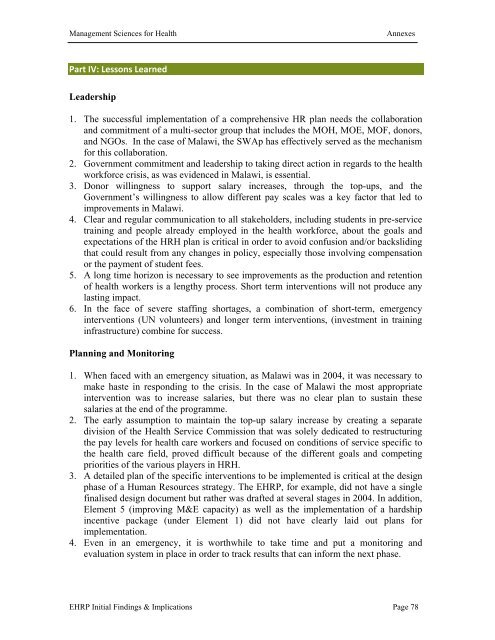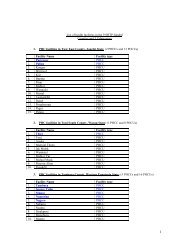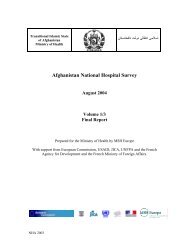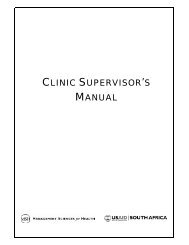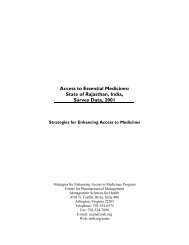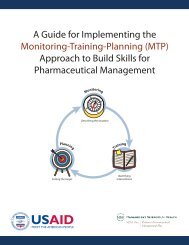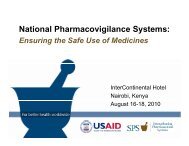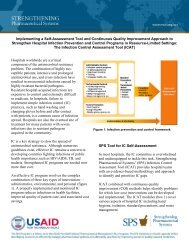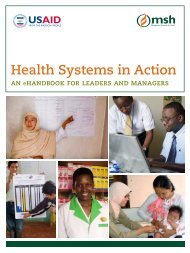Evaluation of Malawi's Emergency Human Resources Programme
Evaluation of Malawi's Emergency Human Resources Programme
Evaluation of Malawi's Emergency Human Resources Programme
You also want an ePaper? Increase the reach of your titles
YUMPU automatically turns print PDFs into web optimized ePapers that Google loves.
Management Sciences for Health Annexes<br />
Part IV: Lessons Learned<br />
Leadership<br />
1. The successful implementation <strong>of</strong> a comprehensive HR plan needs the collaboration<br />
and commitment <strong>of</strong> a multi-sector group that includes the MOH, MOE, MOF, donors,<br />
and NGOs. In the case <strong>of</strong> Malawi, the SWAp has effectively served as the mechanism<br />
for this collaboration.<br />
2. Government commitment and leadership to taking direct action in regards to the health<br />
workforce crisis, as was evidenced in Malawi, is essential.<br />
3. Donor willingness to support salary increases, through the top-ups, and the<br />
Government’s willingness to allow different pay scales was a key factor that led to<br />
improvements in Malawi.<br />
4. Clear and regular communication to all stakeholders, including students in pre-service<br />
training and people already employed in the health workforce, about the goals and<br />
expectations <strong>of</strong> the HRH plan is critical in order to avoid confusion and/or backsliding<br />
that could result from any changes in policy, especially those involving compensation<br />
or the payment <strong>of</strong> student fees.<br />
5. A long time horizon is necessary to see improvements as the production and retention<br />
<strong>of</strong> health workers is a lengthy process. Short term interventions will not produce any<br />
lasting impact.<br />
6. In the face <strong>of</strong> severe staffing shortages, a combination <strong>of</strong> short-term, emergency<br />
interventions (UN volunteers) and longer term interventions, (investment in training<br />
infrastructure) combine for success.<br />
Planning and Monitoring<br />
1. When faced with an emergency situation, as Malawi was in 2004, it was necessary to<br />
make haste in responding to the crisis. In the case <strong>of</strong> Malawi the most appropriate<br />
intervention was to increase salaries, but there was no clear plan to sustain these<br />
salaries at the end <strong>of</strong> the programme.<br />
2. The early assumption to maintain the top-up salary increase by creating a separate<br />
division <strong>of</strong> the Health Service Commission that was solely dedicated to restructuring<br />
the pay levels for health care workers and focused on conditions <strong>of</strong> service specific to<br />
the health care field, proved difficult because <strong>of</strong> the different goals and competing<br />
priorities <strong>of</strong> the various players in HRH.<br />
3. A detailed plan <strong>of</strong> the specific interventions to be implemented is critical at the design<br />
phase <strong>of</strong> a <strong>Human</strong> <strong>Resources</strong> strategy. The EHRP, for example, did not have a single<br />
finalised design document but rather was drafted at several stages in 2004. In addition,<br />
Element 5 (improving M&E capacity) as well as the implementation <strong>of</strong> a hardship<br />
incentive package (under Element 1) did not have clearly laid out plans for<br />
implementation.<br />
4. Even in an emergency, it is worthwhile to take time and put a monitoring and<br />
evaluation system in place in order to track results that can inform the next phase.<br />
EHRP Initial Findings & Implications Page 78


